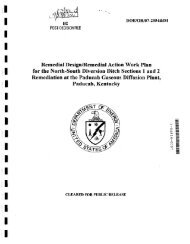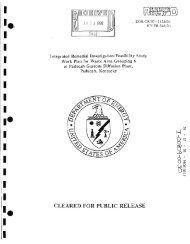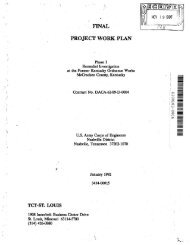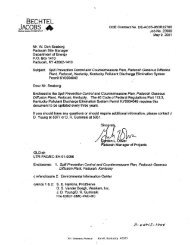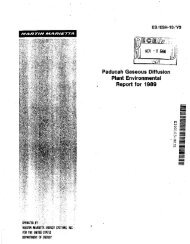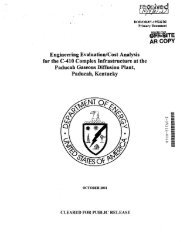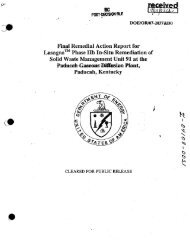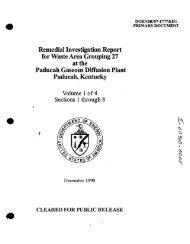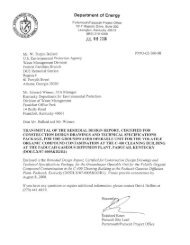1 - paducah environmental information center
1 - paducah environmental information center
1 - paducah environmental information center
You also want an ePaper? Increase the reach of your titles
YUMPU automatically turns print PDFs into web optimized ePapers that Google loves.
Annual Site Environmental Report for 1999<br />
• Sanitary/Industrial waste - waste<br />
that is neither radioactive nor hazardous.<br />
Solid sanitary/industrial waste is basically<br />
refuse or industrial/construction debris<br />
and is disposed in landfills.<br />
identified. Table 3.5 summarizes the major<br />
accomplishments of the Waste Management<br />
Program during 1999.<br />
Waste Minimization I Pollution Prevention<br />
Requirements for meeting waste<br />
management regulatory objectives are varied<br />
and complex because of the variety of waste<br />
streams generated by DOE activities. The goal,<br />
however, is to comply with all current<br />
regulations while planning actions to comply<br />
with anticipated future regulations.<br />
Compliance for waste management<br />
activities involves meeting EPA and state<br />
regulations and DOE orders. In addition to<br />
compliance with these regulations, supplemental<br />
policies are enacted for" management of<br />
radioactive, hazardous, and mixed wastes.<br />
These policies include. reducing the amount of<br />
wastes generated; characterizing and certifying<br />
waste before it is stored, processed, treated, or<br />
disposed; and pursuing volume reduction and<br />
use of on-site storage, when safe and cost<br />
effective, until a final disposal option is<br />
The Pollution Prevention/Waste<br />
Minimization (PPIWM) Program at the Paducah<br />
Site provides guidance and objectives for<br />
minimizing waste generation. Guidance for the<br />
program comes from regulations promulgated<br />
by RCRA, the Pollution Prevention Act,<br />
applicable state and EPA rules, DOE Orders, and<br />
Executive Orders.<br />
The program is striving to meet its goals<br />
with the following strategy:<br />
• source reduction,<br />
o<br />
segregation,<br />
• reuse of materials, and<br />
Table 3.5 Waste Management Accomplishments During 1999<br />
• Shipped 28 cubic meters of PCB/RCRA/ Rad liquid waste to the TSCA Incinerator<br />
• Treated 6.5 cubic meters of pyrophoric uranium metal chips to meet Envirocare of Utah Waste<br />
Acceptance Criteria for future disposal<br />
• Shipped 8 cubic meters of newly generated mixed low level waste to Envirocare of Utah for<br />
treatment and disposal<br />
. .<br />
• Shipped 120 cubic meters of I?w level waste to Envirocare of Utah for disposal<br />
• Issued an Engineering Evaluation/Cost A'nalysis (EE/CA,) for the remov.al of aU scrap metal<br />
• Disposal' of 524 cubic meters of reclassified h~w"level waste in the C-746-U landfill<br />
• Awarded the Waste Operations Subcontract to WESKEM LLC<br />
• Chilracterized'29 waste streams, repre~enting 760 containers of waste under the TCLP FFCA<br />
• Disposed 4;434 cubic meters of industrial waste/construction debris in the C-746-U landfiII<br />
• Continued DMSA projectfield activities and completed corrective actions within 13 DMSAs<br />
• Closed 34 PCB gasket spills and 23 PCB non-gasket s'pills<br />
Environmental Program Information 3-15



